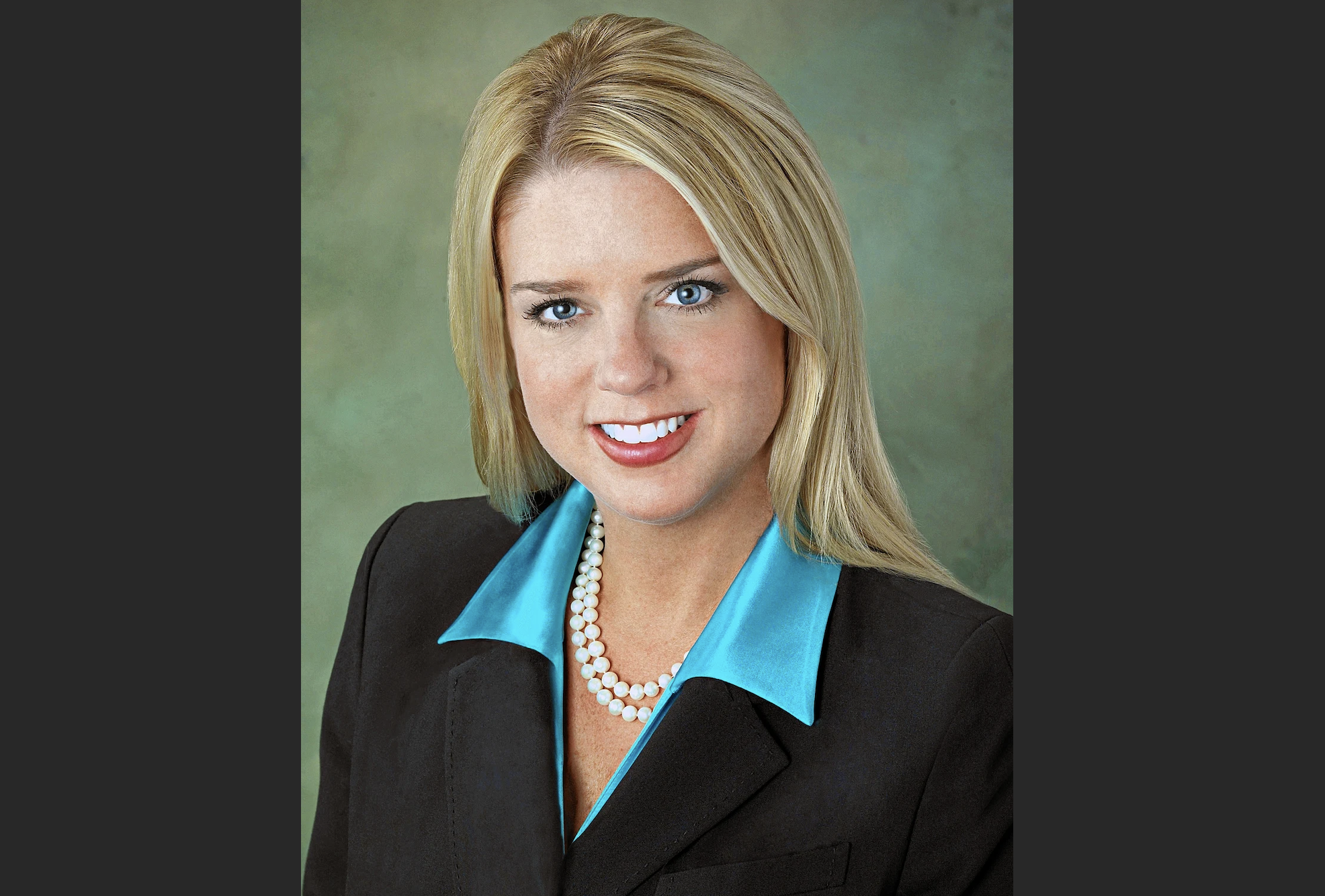
BELGRADE, Montana — Former President Donald Trump and National Republican Senatorial Committee (NRSC) chairman Sen. Steve Daines (R-MT) saw this exact moment in the 2024 election coming years in advance.
Daines told Breitbart News in a long-form exclusive On The Hill special video interview taped back in June at his home just outside Bozeman that he and Trump foresaw a very close presidential race and very close battleground races for U.S. Senate seats. And what they did when they planned this all out was they went to great lengths to produce a slate of GOP senatorial candidates across the battlegrounds that would give the party its best shot at retaking the U.S. Senate majority but also help fuel Trump’s end-of-the-campaign surge with credible and effective allies everywhere.
“As I told President Trump when I first met with him right after I took the job as chairman–this was early 2023–I said ‘Mr. President, the most important thing we can do for you is to give you a Republican Senate majority. The very first phone call you will make after you are elected is to the Senate Majority Leader. It better be a Republican and not Chuck Schumer,’” Daines said in the interview. “We’re in the personnel business. Our founding fathers gave us the advice and consent responsibility for every nominee in the Trump administration—Secretary of State, Secretary of Defense, Secretary of Treasury, director of the CIA. That will go right through the U.S. Senate, not to mention the Supreme Court. A lot at stake, and that’s why the Senate is so important here in 2024.”
One of the key successes of the 2016 presidential campaign from Trump—in which he won nearly all the battleground states, as did Senate Republicans—is that all of those Senate GOP candidates, with two exceptions, stood with Trump all the way through that contentious election. Trump won the battleground states in 2016 where there were Senate contests except New Hampshire and Nevada—the only two states where Senate GOP candidates un-endorsed him later in the race—and the Senate Republican candidates also won all their races. That election helped Senate Republicans continue a majority they won in 2014, and held until 2020 when the Senate fell to 50-50 in terms of partisan control but then fell to the Democrats because Democrats took the White House and Vice President Kamala Harris became the tie-breaking vote. Democrats added a seat in the 2022 midterm elections, and the partisan breakdown—technically all the Senate “independents” caucus with Democrats—is now 51 for the Democrats and 49 for the Republicans.
“The margins have really never been narrower historically. We were at 50-50 in the Senate last Congress. We’re 49-51 in this Congress,” Daines told Breitbart News. “But the ideological divide between Republicans and Democrats has just never been larger. Kamala Harris has broken more ties as Vice President than any Vice President in our nation’s history. We’ve had 47 vice presidents—she’s number one. She’s broken some major, consequential-type ties, like for example the $1.9 trillion stimulus package borrowing all this money and launching into the economy borrowed money. That was inflationary. You look at the ‘Inflation Reduction Act.’ That was an incredibly terrible piece of legislation passed on a tie-breaking vote by Kamala Harris. So you take a look at what’s up right now in the Senate, you’ve got to find candidates working with President Trump that can win not only primary elections but general elections. Winners make policy. Losers go home.”
In a clip of this interview published in July, Daines laid out the stakes of what happens if Republicans do not take the U.S. Senate majority: Democrats have made clear they intend to make Puerto Rico and Washington, DC, states, eliminate the Senate filibuster, and nationalize elections. In other words, it becomes essentially game over for the GOP—the party has to win this cycle or face a long and uncertain future in the wilderness.
Similarly, Trump faces serious stakes in this election, as does the nation as a whole, when it comes to who wins the White House. This interview with Daines was taped before Democrats ditched President Joe Biden as their nominee in favor of Harris, but the stakes are all the same regardless of who Democrats put forward. So Daines and Trump got together early this cycle—Daines was one of the first Senate Republicans to endorse him way back in the early days of the primary, and was certainly the first member of Senate GOP leadership to back Trump—and talked through how they can help each other. Trump’s eldest son Donald Trump Jr., an avid hunter, is particularly close with Daines and regularly comes out to Montana with him to hunt.
“First of all, my relationship [with Trump] goes back to right after he was elected,” Daines said. “Donald Trump Jr. came out to Montana and we went hunting elk together and killed a couple elk together. We were hunting together with Don’s sweet little boy and now he’s nearly a grown man but we had a great time. The four best years I’ve had in the U.S. Senate were when President Trump was in office. Think about what we got to do, moving the ball down the field in a significant way, changing the Supreme Court, cutting taxes, and passing the greatest conservation win in 50 years, by the way, which was done by President Trump, the Great America Outdoors Act.”
The 2016 closeness between Trump’s campaign and Senate Republicans’ efforts to hold their then-nascent majority kind of came together by accident and out of convenience for the two entities. But this time, the coordination is no accident.
“It’s been very intentional,” Daines said. “One of our strategies, looking at what happened in the last cycle in 2022 where instead of gaining Senate seats in the ’22 election we actually went in reverse and lost a Senate seat. With so much at stake, one of our key strategies was from finding candidates who could win not just primaries but general elections. Really, as I look at it, as President Trump and I discussed, you’ve got to have the MAGA side of our party behind the candidates and you’ve got to expand that more broadly across the Republican base, but importantly you’ve also got to have independent voters. I think about what Ronald Reagan did once upon a time. He was the first president I got to vote for in 1980 as a freshman at Montana State University. So, President Trump and I had that conversation early before anybody was hardly endorsing President Trump. I endorsed President Trump early in my leadership at the NRSC, first because I thought he’s the best president, but also because I thought it was important to be working together with this president.”
After Daines endorsed Trump, he and Trump went through the plan to get to 51 or more Republicans in the U.S. Senate. First off, Republicans have to play defense in two key red states, Florida and Texas, to make sure Sens. Rick Scott (R-FL) and Ted Cruz (R-TX) win reelection. If they hold those, then the GOP just has to flip a net two sets from Democrat hands into GOP control to win back the majority in the upper chamber of Congress. The easiest pickup opportunity, Daines said, is West Virginia, where Sen. Joe Manchin—who recently left the Democrat Party but still caucuses with Democrats—currently sits in the seat. But it was no sure thing he would not seek reelection at first—until Daines and Trump worked to make sure Gov. Jim Justice was the GOP nominee. That knocked out Manchin early, and put Republicans on the glide path to at least one pickup.
“As we went through these races, starting with West Virginia, we recruited Gov. Jim Justice,” Daines told Breitbart News. “I worked with President Trump to endorse Gov. Justice. He was beating Joe Manchin by 20 points in the polls. I told President Trump, I said, ‘If you endorse Jim Justice, we will likely see Joe Manchin drop out of the race. He will retire.’ That’s exactly what happened. The president called me in September [2023] and said ‘Steve, I’ve got good news for you.’ I said, ‘What’s that?’ He said ‘I’m endorsing Gov. Jim Justice in West Virginia.’ He calls him ‘Big Jim.’ I said, ‘That’s fantastic news.’ As soon as that endorsement news went out, Manchin two weeks later announced his retirement. So that is a pickup seat for Republicans which is very important—that takes us from 49-51 to 50-50. Without spending any money in West Virginia, we just picked up a U.S. Senate race. Otherwise, had Manchin stayed in that race, it might have been a $50 million or even $100 million race.”
After West Virginia, next up are Montana and Ohio. Incumbent Sen. Jon Tester (D-MT), a Democrat who’s regularly been a partisan stalwart for Democrats in the Senate, is now facing GOP candidate Tim Sheehy on next week’s ballot. Polls show Sheehy—a businessman and Navy SEAL combat veteran—in prime position to defeat Tester, but again it was no sure thing when this all started. In Ohio, businessman Bernie Moreno faces incumbent Democrat Sen. Sherrod Brown (D-OH). Polls similarly show Moreno with the edge there, as Brown—another partisan stalwart for radical Democrats—slips down in the final weeks.
Daines made clear that if the GOP does not take these three seats this year—West Virginia, Montana, and Ohio—the odds for a GOP Senate majority before the end of the decade drop big time.
“An important point to consider a little longer-term as you look between now and 2030: When I first took over the chairmanship, I took a look at the 2024 map. There’s three red states that have Democrats up,” Daines said. “We’ve talked about West Virginia and then it’s Montana and it’s Ohio. In each one of those red states, every statewide elected official is a Republican except for Joe Manchin, Jon Tester, and Sherrod Brown. In each of those three states Trump is going to win—he’ll win West Virginia by 40, Montana by 20, and he’s going to win Ohio by about 10. Red. But when you start looking at the out-cycles, like 2026, how many red states have Democrats up in 2026? The answer is zero. That was a sobering moment early in my leadership assignment here at the NRSC. Then I peeked over the hill and looked at 2028. How many red states have Democrats up in the Senate [in 2028]? Zero. So it’s three this cycle. It’s zero in 2026 and it’s zero in 2028. Here’s the point: If we claim the majority, we likely can hold that enduring majority through the end of the decade. But the sobering thought is if we don’t get the majority this cycle, we’re likely in the minority the rest of the decade and that’s a frightening thought for the future of this great country.”
When Daines—himself a business guy before politics—first came to the national scene in Montana as a U.S. Representative for the at-large congressional district in the state (the state has since been awarded another district and has two U.S. House seats now), the rest of the major officeholders in Montana were Democrats. He’s overseen a GOP revolution of sorts in Montana, and now every major officeholder in the state is a Republican—except Tester. Asked what’s fueled this GOP revolution in Montana, Daines said it’s partly the GOP has made inroads with voters and it has shifted to the right—but more importantly the Democrats’ far-left turn at a national level has alienated the state known for its “libertarian streak.”
“The state has shifted more to the right over time, but I think it’s more the Democrats shifted more far left,” Daines said. “The parallels between a Montana and say an Ohio, which used to be more of a blue collar swing state in the electoral college if you go back 20 or 25 years—Ohio is now a very predictable red state in the presidential and a red state for statewide elected officials. In Montana, in 2012, I first ran for an at-large statewide U.S. congressional seat. There was only one statewide elected Republican and seven statewide elected Democrats. Today, there are nine major officeholders and eight are Republicans and only Jon Tester is the last remaining Democrat. I think it’s a combination of finding better candidates who can win these races and also putting out a clearer message about what we stand for. When I ran in 2012 for the U.S. House, I had 28 years of business experience in the private sector. I was a job creator. My campaign came down to four words—more jobs, less government. Yes, it’s about more jobs and higher-paying jobs, but also less government. We have a little bit of a libertarian streak out here in Montana. We want the government to stay out of our way of life here in Montana. We won that seat. As we sort of watched that go cycle by cycle, now the governor of Montana Greg Gianforte, he was my business partner for the last 25 years. We were in the private sector together, and we never had plans to be in politics. But I’m really grateful to see another business guy as governor and I’m grateful to be a U.S. senator.”
As for Sheehy’s plan for victory here in Montana, Daines said that Democrats had spent tens of millions of dollars in ads and the best they could do as of the end of June was have the race tied.
“They’ve dropped 30 million dollars of advertising—30 million in a state that only has a million people,” Daines said. “We’ve got three times as many cows as we’ve got people in the state of Montana. They’re lighting up the airwaves. Any time you pour that much money into personal attacks against a candidate, that starts to have an effect. The second thing is it’s a name ID gap right now. Jon Tester has been a statewide elected official in Montana for 18 years. People know Jon Tester. People know his name. As we get closer to the election you’re going to see Sheehy’s numbers start to go a little bit higher because we’ll close that name ID gap. Right now, think about this: There’s been 30 million dollars in negative ads dropped on Tim Sheehy and the race is tied. Pretty remarkable and it shows you the resilience of Tim Sheehy. We’ve just got to get his story out. But the funding gap here is unlike anything in the country. The Democrats have a huge advantage here in Montana and this is where we’ve got to shore up the fundraising side here in Montana to get our message out.”
Since the interview, what Daines predicted has come to pass. Sheehy has taken a very clear lead in the polls, and most forecasters expect Tester to lose to Sheehy on Tuesday. Daines’s advice to Sheehy throughout the race has been to ignore the noise from Tester and Democrats and instead focus on the issues—and that has worked.
“I actually had the most expensive race in the history of America on a per-vote basis when I ran for my reelect in 2020. I ran against a very popular Democrat Governor, Steve Bullock,” Daines said. “It was a $210 million race in Montana. I was outspent by $50 million. That’s like having a $4 billion race in Florida if you think about it for population normalization. They had all kinds of nasty attacks on my background, my business, and everything else. Anytime you’re successful you have lots of things to talk about and they’re always going to find one disgruntled employee, this and that and so forth. My advice to Tim Sheehy is keep talking about the issue set. Keep talking about the contrast and you talk about what you stand for, to stand for securing the southern border, to stop this Biden economy which is the worst economy in my lifetime with 20-percent-plus inflation. Stay true to what you believe in, paint the contrast, and when Montanans see how Jon Tester voted versus what they’re seeing on TV right now from Democrats–when we paint that contrast and you’ll see a lot of voters say I want to be with President Trump and I want to be with Tim Sheehy. The first thing President Trump says is we need to hire Tim Sheehy and fire Jon Tester. President Trump needs a senator who will vote with him, not against him, every time, like Jon Tester demonstrated while Trump was president for four years.”
Daines said the game plan in Ohio for Moreno and Republicans is very similar to what has played out in Montana.
“Bernie had a convincing win in the primary,” Daines said. “He won every one of Ohio’s 88 counties. It was a very impressive victory against two formidable Republicans in that primary. Bernie’s got a great story. It’s an American success story. He’s a Colombian immigrant. He speaks Spanish and there’s a lot of assets that Bernie has, and his wonderful sweet wife Bridget. You look at Ohio and President Trump is going to win Ohio by about 10 points. The Democrat Party has left the working class people of Ohio. These are working class voters that are not showing up at Republican events but they say they can’t vote for a Democrat anymore because on the core issues of energy, oil, natural gas, coal, the left has gone nuts on trying to shut down all sources of carbon energy. That really hits at the heart of Ohio’s economy and the working class. And their woke agenda–it’s just repulsive. Bernie has a strong relationship with President Trump. President Trump will be in Ohio campaigning for Bernie. Sherrod Brown, this is the contrast, he opposed everything Trump stood for when he was president. He spent 50 years—50 years—in elected office. I think this is a change election coming up.”
If Republicans are able to take just those three seats and hold Texas and Florida, they would get to a convincing 52-seat majority in the U.S. Senate. But those are not the only opportunities on the chessboard this year for the GOP; Republicans are competing in Arizona, Nevada, Michigan, Wisconsin, and Pennsylvania in the home stretch and even have outside shots in places like New Mexico or Virginia too. If the GOP takes even a handful of these, the Republicans could build a majority that lasts the rest of the decade.
The GOP nominees in these various places all seem to have something clear in common. In Arizona, Kari Lake is a wildly popular nearly-successful gubernatorial candidate and former television anchor. In Nevada, Sam Brown is a literally scarred war hero with burns covering his body after surviving a roadside bombing in Afghanistan. In Michigan, former Rep. Mike Rogers (R-MI) is a veteran and former FBI agent who served as chairman of the House Intelligence Committee in Congress. In Wisconsin, Eric Hovde is a businessman worth millions. In Pennsylvania, David McCormick is a West Point graduate and military veteran who also happens to have built a wildly successful career in business and is also worth millions.
Asked if these commonalities—business background and military service—were key to his and Trump’s selections of candidates, Daines said they very much were.
“I think the American people want to see leaders who have experience in the real world, that have been successful in the real world, and have really signed the front of a paycheck,” Daines said. “I look at another thread in this particular election cycle is not only these business leaders, but also this military background. Tim Sheehy, Naval Academy graduate, 100 combat missions as a Navy SEAL. His wife also a Marine from the Naval Academy. They were in Afghanistan for six years deployed as a married couple and saw each other 45 days—married by a judge in Kalispell, Montana, because we’re the only state that will do a double-proxy wedding as they were both on the battlefield. Then he comes back here to Montana and creates a successful business. Dave McCormick, West Point graduate, 82nd Airborne, and successful businessman. Sam Brown in Nevada, West Point graduate and great story of heroism there—he nearly got killed by a bomb by the Taliban in Afghanistan. You look at Mike Rogers in Michigan, also a veteran—an Army veteran. I think when you start taking a look at the chaos going in the world and going on in our country, the discipline of someone with a military background is definitely an asset.”
One of the key things for each race across the board, and Daines goes in depth on every single one in this interview, is focusing on the voting record of the Democrat. Republicans, he said, have to articulate to voters that despite these Democrats’ “moderate image” they present to the public that “what matters is how you vote.”
“Make sure the voters see their voting records and that’s going to be very clear of course in a state like Montana, like Ohio, and a state like Pennsylvania,” Daines said. “One thing about Pennsylvania I need to point out: what’s different about this cycle compared with 2022 is Dave McCormick didn’t have a primary. He is a great candidate with a great business background, West Point graduate, [veteran with] the 82nd Airborne, but he was unopposed in the primary. The state party endorsed him—unheard of. We cleared the primary. There were some candidates thinking about primarying Dave McCormick but working with Dave and working with President Trump and working with our teams, we cleared that and that really allows him to come out of a primary without any battle scars to beat Bob Casey in November.”
The most remarkable thing about this broader plan, however, is that despite the best efforts of Democrats—most notably that they outspent Republicans all year—each of these races remains in contention as the nation heads into election day next week. Republicans actually held the line, per the original Daines and Trump plan, and while it remains to be seen which ones of these candidates will win or not, the fact that they are all closing strong and have a shot to pull it off from Montana to Ohio to Arizona to Nevada to Michigan to Wisconsin to Pennsylvania is frankly nothing short of incredible. The polls and early vote data in each of these places show competitive races, and if Trump and Daines both succeed in their objectives—winning the White House and winning a U.S. Senate majority for the Republicans—this original alliance forged years ago and this plan they hatched at the beginning of this election cycle will have played no small part in making it happen. Daines said he’s spoken with Trump and that Trump is “excited that he’s going to have candidates he’s excited to stand on stage with.”
“Keep in mind: If you look at the last two presidential elections where Trump has been on the ballot, 2016 and 2020, in 68 of the 69 Senate races that were up in 2016 and 2020, whoever won the presidency also won the Senate seat in terms of that party,” Daines said. “So a state that Trump wins, our Senate candidate won that in 2016 as well as 2020. If Biden [or Clinton] won the state, the Senate Democrat candidate won it in 2016 or 2020—68 out of 69 times. The only exception to that was Susan Collins in Maine where Biden won the state of Maine and Susan Collins kept a Republican seat. So when you start looking at 2024 and kind of macro trends, as we get closer to election day and President Trump continues to strengthen and strengthen his leads, it becomes increasingly difficult for the Democrats to outpace that and it will become an advantage, certainly, for a Republican candidate.”
Originally Posted At www.breitbart.com








